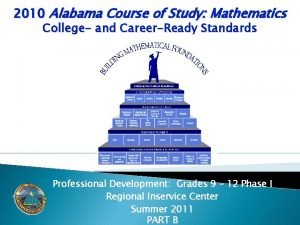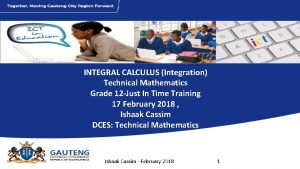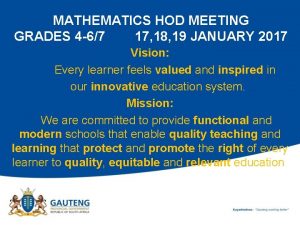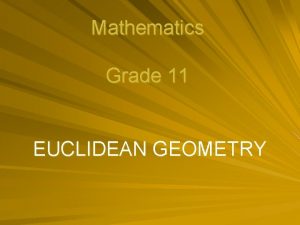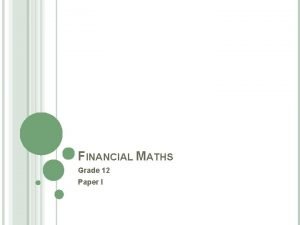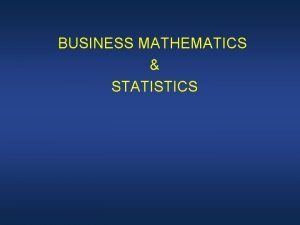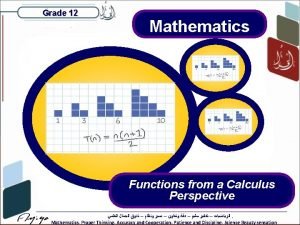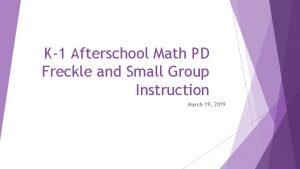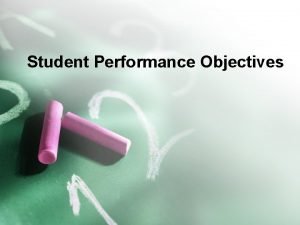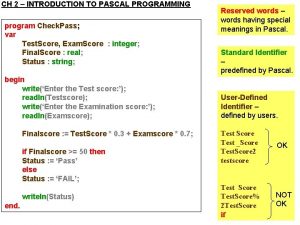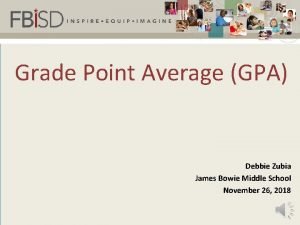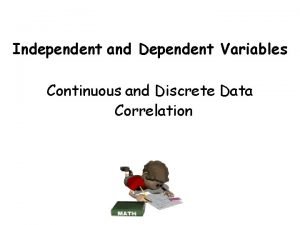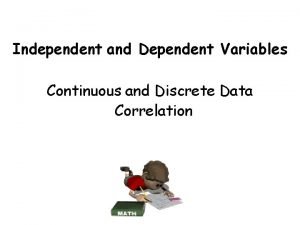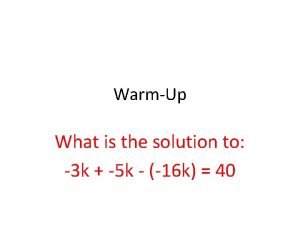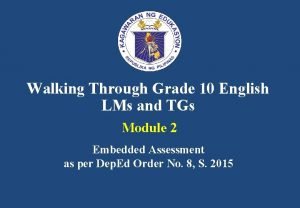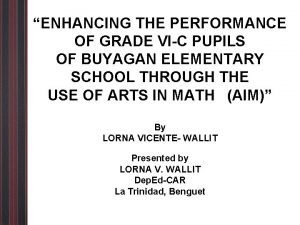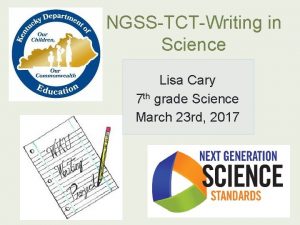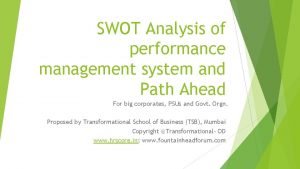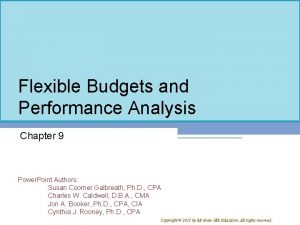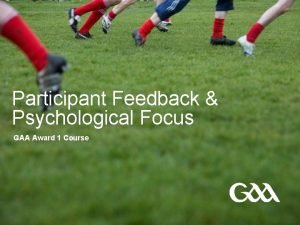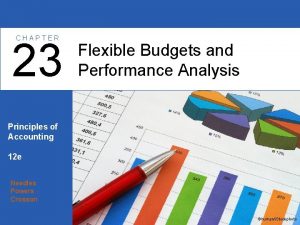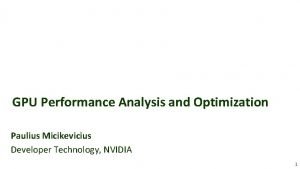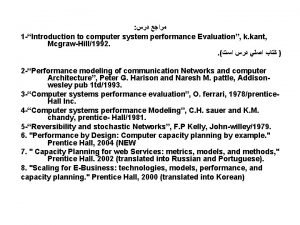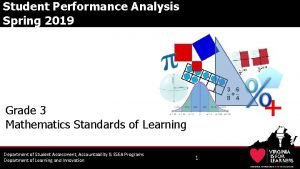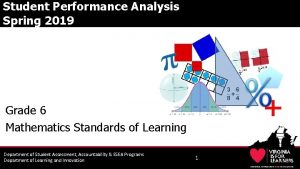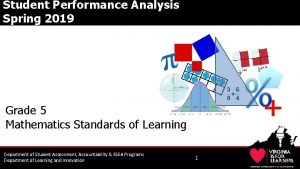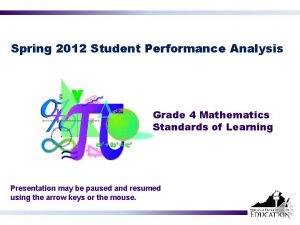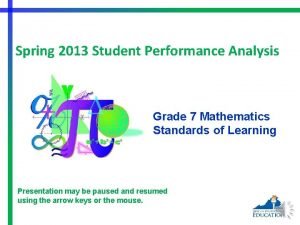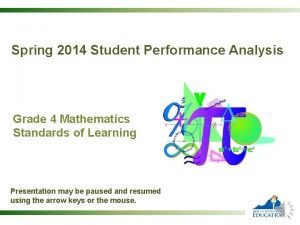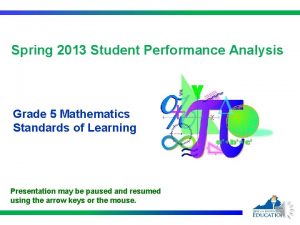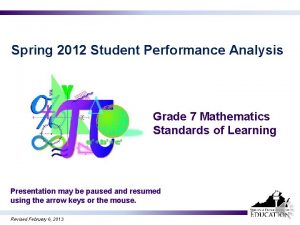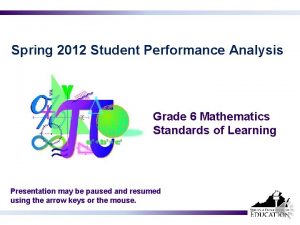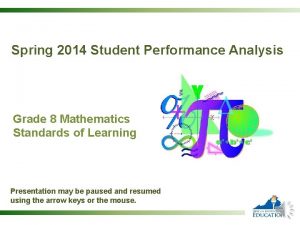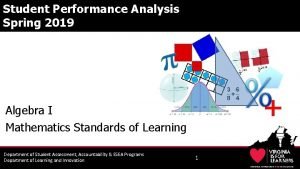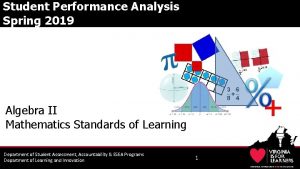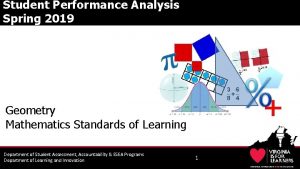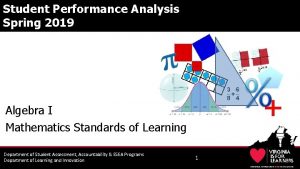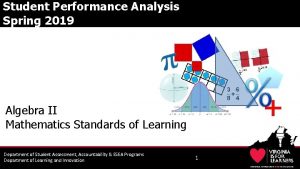Student Performance Analysis Spring 2019 Grade 5 Mathematics

















































- Slides: 49

Student Performance Analysis Spring 2019 Grade 5 Mathematics Standards of Learning Department of Student Assessment, Accountability & ESEA Programs Department of Learning and Innovation 1

Student Performance Analysis Spring 2019 (1 of 3) Statewide results for the spring 2019 mathematics tests based on the 2016 Mathematics Standards of Learning (SOL) have been analyzed to determine specific content that may have challenged students. In order to support preparation of students for the Grade 5 Mathematics test, this Power. Point presentation has been developed to provide examples of SOL content identified by this analysis. Department of Student Assessment, Accountability & ESEA Programs Department of Learning and Innovation 2

Student Performance Analysis Spring 2019 (2 of 3) It should be noted that these items are not SOL test questions and are not meant to mimic SOL test questions. Instead, they are intended to provide mathematics educators with further insight into the concepts that challenged students statewide. Department of Student Assessment, Accountability & ESEA Programs Department of Learning and Innovation 3

Student Performance Analysis Spring 2019 (3 of 3) It is important to keep the content of this statewide analysis in perspective. The information provided here should be used as supplemental information. Instructional focus should remain on the standards as a whole, with school- or division-level data being used as the focal guiding resource to help improve instruction. Department of Student Assessment, Accountability & ESEA Programs Department of Learning and Innovation 4

Using Decimals SOL 5. 5 The student will a) estimate and determine the product and quotient of two numbers involving decimals; and b) create and solve single-step and multistep practical problems involving addition, subtraction, and multiplication of decimals, and create and solve singlestep practical problems involving division of decimals. Department of Student Assessment, Accountability & ESEA Programs Department of Learning and Innovation 5

Practical Problems with Decimals (5. 5 b) Students need additional practice solving multistep practical problems with decimals. Common errors include: • determining the answer to one part of a multistep problem, but not completing all steps; and • using an incorrect operation (example: addition instead of subtraction). Department of Student Assessment, Accountability & ESEA Programs Department of Learning and Innovation 6

Suggested Practice #1 with Multistep Problems with Decimals (5. 5 b) Jeremy ran 1. 4 miles each day for eight days. Amelia ran 2. 1 miles each day for eight days. What is the difference in the total distance Amelia and Jeremy ran in these eight days? A. B. C. D. 0. 7 mile 3. 5 miles 5. 6 miles 28 miles Department of Student Assessment, Accountability & ESEA Programs Department of Learning and Innovation 7

Answer to Practice #1 with Multistep Problems with Decimals (5. 5 b) Jeremy ran 1. 4 miles each day for eight days. Amelia ran 2. 1 miles each day for eight days. What is the difference in the total distance Amelia and Jeremy ran in these eight days? A. B. C. D. 0. 7 mile 3. 5 miles 5. 6 miles 28 miles Common error: finding the difference in the number of miles run in one day. Department of Student Assessment, Accountability & ESEA Programs Department of Learning and Innovation 8

Suggested Practice #2 with Multistep Problems with Decimals (5. 5 b) Billy’s puppy weighs 8. 6 kilograms (kg). Myra’s puppy weighs 3. 5 times as much as Billy’s puppy. What is the combined weight of these two puppies? A. B. C. D. 12. 1 kg 30. 1 kg 36. 3 kg 38. 7 kg Department of Student Assessment, Accountability & ESEA Programs Department of Learning and Innovation 9

Answer to Practice #2 with Multistep Problems with Decimals (5. 5 b) Billy’s puppy weighs 8. 6 kilograms (kg). Myra’s puppy weighs 3. 5 times as much as Billy’s puppy. What is the combined weight of these two puppies? A. B. C. D. 12. 1 kg 30. 1 kg 36. 3 kg 38. 7 kg Common error: when the problem involves a comparison, some students add the numbers given instead of using the comparison to find the unknown number and then solving. Department of Student Assessment, Accountability & ESEA Programs Department of Learning and Innovation 10

Practical Problems with Fractions SOL 5. 6 The student will a) solve single-step and multistep practical problems involving addition and subtraction with fractions and mixed numbers; and b) solve single-step practical problems involving multiplication of a whole number, limited to 12 or less, and a proper fraction, with models. Department of Student Assessment, Accountability & ESEA Programs Department of Learning and Innovation 11

Practical Problems with Fractions (5. 6 a) Students need additional practice solving practical problems involving fractions, particularly when regrouping is required. Common errors include: • determining the answer to one part of a multistep problem, but not completing all steps; • using an incorrect operation; and • subtracting the numerator of the first fraction from the numerator of the second fraction rather than regrouping to subtract. Department of Student Assessment, Accountability & ESEA Programs Department of Learning and Innovation 12

Suggested Practice #1 with Practical Problems with Fractions (5. 6 a) • Department of Student Assessment, Accountability & ESEA Programs Department of Learning and Innovation 13

Answer to Practice #1 with Practical Problems with Fractions (5. 6 a) • Common error: adding the two given fractions and not subtracting from 2. Department of Student Assessment, Accountability & ESEA Programs Department of Learning and Innovation 14

Suggested Practice #2 with Practical Problems with Fractions (5. 6 a) • Department of Student Assessment, Accountability & ESEA Programs Department of Learning and Innovation 15

Answer to Practice #2 with Practical Problems with Fractions (5. 6 a) •

Practical Problems with Fractions (5. 6 b) Students need additional practice solving practical problems using models to multiply a whole number and a proper fraction, particularly when they are identifying the result of the multiplication. Common errors on SOL test items vary. Students would benefit from additional practice with models. Department of Student Assessment, Accountability & ESEA Programs Department of Learning and Innovation 17

Suggested Practice #1 with Practical Problems with Fractions (5. 6 b) • Department of Student Assessment, Accountability & ESEA Programs Department of Learning and Innovation 18

Answer to Practice #1 with Practical Problems with Fractions (5. 6 b) • Department of Student Assessment, Accountability & ESEA Programs Department of Learning and Innovation 19

Equivalent Measures in the Metric System SOL 5. 9 The student will a) given the equivalent measure of one unit, identify equivalent measurements within the metric system; and b) solve practical problems involving length, mass, and liquid volume using metric units. Department of Student Assessment, Accountability & ESEA Programs Department of Learning and Innovation 20

Finding Equivalent Measures (5. 9 a) Students need additional practice finding equivalent measures when more than one calculation is required. Common errors on SOL test items vary but suggest students have difficulty when the options are very similar and when they must fill in the answer. Department of Student Assessment, Accountability & ESEA Programs Department of Learning and Innovation 21

Suggested Practice #1 with Finding Equivalent Measures (5. 9 a) Ethan has some materials for a project. He has 5. 62 meters of rope and 562 milliliters of paint. He knows: 1 meter = 100 centimeters 1 liter = 1000 milliliters Find the equivalent measurements. 5. 62 meters = centimeter(s) 562 milliliters = liter(s) 0. 0562 0. 562 5. 62 562 5, 620 56, 200 Department of Student Assessment, Accountability & ESEA Programs Department of Learning and Innovation 22

Answer to Practice #1 with Finding Equivalent Measures (5. 9 a) Ethan has some materials for a project. He has 5. 62 meters of rope and 562 milliliters of paint. He knows: 1 meter = 100 centimeters Common error: 1 liter = 1000 milliliters Using the inverse Find the equivalent measurements. operation to get 0. 0562 centimeter 5. 62 meters = 562 centimeter(s) and 56, 200 liters. 562 milliliters = 0. 562 liter(s) 0. 0562 0. 562 5. 62 562 5, 620 56, 200 Department of Student Assessment, Accountability & ESEA Programs Department of Learning and Innovation 23

Suggested Practice #2 with Finding Equivalent Measures (5. 9 a) Maurice has 1. 5 liters of lemonade in one pitcher and 98 milliliters of lemonade in another pitcher. 1 liter = 1000 milliliters How many milliliters of lemonade does he have altogether? A. B. C. D. 1. 598 milliliters 99. 5 milliliters 995 milliliters 1598 milliliters Department of Student Assessment, Accountability & ESEA Programs Department of Learning and Innovation 24

Answer to Practice #2 with Finding Equivalent Measures (5. 9 a) Maurice has 1. 5 liters of lemonade in one pitcher and 98 milliliters of lemonade in another pitcher. 1 liter = 1000 milliliters How many milliliters of lemonade does he have altogether? Common errors on SOL test items include selecting the equivalent A. 1. 598 milliliters answer in liters (1. 598) and B. 99. 5 milliliters C. 995 milliliters adding 98 and 1. 5 to get 99. 5. D. 1598 milliliters Department of Student Assessment, Accountability & ESEA Programs Department of Learning and Innovation 25

Angles of Triangles SOL 5. 13 The student will a) classify triangles as right, acute, or obtuse and equilateral, scalene, or isosceles; and b) investigate the sum of the interior angles in a triangle and determine an unknown angle measure. Department of Student Assessment, Accountability & ESEA Programs Department of Learning and Innovation 26

Finding Unknown Angle Measures of Triangles (5. 13 b) Students need additional practice using models to prove that the sum of the interior angles of a triangle is 180 degrees, and using that relationship to determine an unknown angle measure in a triangle. Common errors include calculating the missing angle as the sum of the two given angles, calculating the missing angle as the difference of the two given angles, and setting the sum of the three angles equal to 100 or 200 degrees instead of 180. Department of Student Assessment, Accountability & ESEA Programs Department of Learning and Innovation 27

Suggested Practice #1 with Angles of Triangles (5. 13 b) • Department of Student Assessment, Accountability & ESEA Programs Department of Learning and Innovation 28

Answer to Practice #1 with Angles of Triangles (5. 13 b) • Common error: Selecting the sum or difference of the two given angle measures. Department of Student Assessment, Accountability & ESEA Programs Department of Learning and Innovation 29

Representing and Interpreting Data SOL 5. 16 The student, given a practical problem, will a) represent data in line plots and stem-and-leaf plots; b) interpret data represented in line plots and stem-and-leaf plots; and c) compare data represented in a line plot to the same data represented in a stem-and-leaf plot. Department of Student Assessment, Accountability & ESEA Programs Department of Learning and Innovation 30

Comparing Data (5. 16 c) Students need additional practice comparing data represented in a line plot and data represented in a stem and leaf plot. Department of Student Assessment, Accountability & ESEA Programs Department of Learning and Innovation 31

Suggested Practice with Comparing Plots (5. 16 c) Mr. Fox recorded the grades 16 students earned on a quiz. He thought he recorded the same data on the stem-and-leaf plot and the line plot. Which data point did Mr. Fox forget to record on the stem-and-leaf plot? Each x represents one quiz grade.

Answer to Practice with Comparing Plots (5. 16 c) Mr. Fox recorded the grades 16 students earned on a quiz. He thought he recorded the same data on the stem-and-leaf plot and the line plot. Which data point did Mr. Fox forget to record on the stem-and-leaf plot? 84 Each x represents one quiz grade.

Mean, Median, Mode, and Range SOL 5. 17 The student, given a practical context, will a) describe mean, median, and mode as measures of center; b) describe mean as fair share; c) describe the range of a set of data as a measure of spread; and d) determine the mean, median, mode, and range of a set of data. Department of Student Assessment, Accountability & ESEA Programs Department of Learning and Innovation 34

Finding a Range (5. 17 c) Students need additional practice finding the range of a set of data when the data is presented in a format other than a list or table. Common errors on SOL test items involve confusion between the highest possible number (score, grade, etc. ) that could be attained in a data set versus the greatest value contained in the data set. Department of Student Assessment, Accountability & ESEA Programs Department of Learning and Innovation 35

Four students threw balls at a target. Each student threw 10 balls at the target. The bar graph shows the number of times each student hit the target with a ball. What is the range in the number of balls that hit the target? A. 3 C. 7 Balls Hitting Target Suggested Practice #1 with Finding a Range (5. 17 c) B. 6 D. 9 Department of Student Assessment, Accountability & ESEA Programs Department of Learning and Innovation 36 10 9 8 7 6 5 4 3 2 1 0

Four students threw balls at a target. Each student threw 10 balls at the target. The bar graph shows the number of times each student hit the target with a ball. What is the range in the number of balls that hit the target? A. 3 Common C. 7 error Balls Hitting Target Answer to Practice #1 with Finding a Range (5. 17 c) B. 6 D. 9 Department of Student Assessment, Accountability & ESEA Programs Department of Learning and Innovation 37 10 9 8 7 6 5 4 3 2 1 0

Suggested Practice #2 with Finding Range (5. 17 c) Five students took a quiz. The quiz was worth 100 points. The scores on the quiz for 4 of the students is shown. The spread on the quiz scores was 22. 88 86 94 74 The score for the fifth student was either Department of Student Assessment, Accountability & ESEA Programs Department of Learning and Innovation or 38

Answer to Practice #2 with Finding Range (5. 17 c) Five students took a quiz. The quiz was worth 100 points. The scores on the quiz for 4 of the students is shown. The spread on the quiz scores was 22. 88 86 94 74 The score for the fifth student was either 72 or 96 Common errors include subtracting 22 from 100 to get 78, subtracting 22 from 88 to get 66, or not realizing that 94 might not be the highest score. Department of Student Assessment, Accountability & ESEA Programs Department of Learning and Innovation 39

Expressions and Equations with Variables SOL 5. 19 The student will a) investigate and describe the concept of variable; b) write an equation to represent a given mathematical relationship, using a variable; c) use an expression with a variable to represent a given verbal expression involving one operation; and d) create a problem situation based on a given equation, using a single variable and one operation. Department of Student Assessment, Accountability & ESEA Programs Department of Learning and Innovation 40

Writing Expressions with Variables (5. 19 c) Students need additional practice writing expressions with variables to represent a given verbal expression. Common errors include: • reversing the order when writing an expression that involves subtraction; and • reversing the order when writing an expression that involves division. Department of Student Assessment, Accountability & ESEA Programs Department of Learning and Innovation 41

Suggested Practice #1 with Writing Expressions (5. 19 c) • Department of Student Assessment, Accountability & ESEA Programs Department of Learning and Innovation 42

Answer to Practice #1 with Writing Expressions (5. 19 c) • Common error Department of Student Assessment, Accountability & ESEA Programs Department of Learning and Innovation 43

Suggested Practice #2 with Writing Expressions (5. 19 c) • Department of Student Assessment, Accountability & ESEA Programs Department of Learning and Innovation 44

Answer to Practice #2 with Writing Expressions (5. 19 c) • Department of Student Assessment, Accountability & ESEA Programs Department of Learning and Innovation 45

Suggested Practice #3 with Writing Expressions (5. 19 c) • Department of Student Assessment, Accountability & ESEA Programs Department of Learning and Innovation 46

Answer to Practice #3 with Writing Expressions (5. 19 c) • Department of Student Assessment, Accountability & ESEA Programs Department of Learning and Innovation 47

Practice Items This concludes the student performance information for the spring 2019 Grade 5 SOL test. Additional information on accessing practice items and the Guided Practice Suggestions can be found on the Virginia Department of Education website. Department of Student Assessment, Accountability & ESEA Programs Department of Learning and Innovation 48

Contact Information • For questions regarding assessment, please contact student_assessment@doe. virginia. gov • For questions regarding instruction, please contact vdoe. mathematics@doe. virginia. gov Department of Student Assessment, Accountability & ESEA Programs Department of Learning and Innovation 49
 Cast of spring, summer, fall, winter... and spring
Cast of spring, summer, fall, winter... and spring Autumn winter summer
Autumn winter summer Alabama course of study math 2019
Alabama course of study math 2019 Predicate computer science
Predicate computer science Myskillsfuture primary
Myskillsfuture primary Technical mathematics grade 12 pdf
Technical mathematics grade 12 pdf Hod master file index
Hod master file index Euclidean geometry theorems and proofs grade 11
Euclidean geometry theorems and proofs grade 11 Grade 12 financial maths formulas
Grade 12 financial maths formulas Ratio and proportion business math
Ratio and proportion business math Mathematics functions grade 12
Mathematics functions grade 12 Grade 5 creative arts term 3
Grade 5 creative arts term 3 History ia grade boundaries
History ia grade boundaries How's your last weekend
How's your last weekend What did you do in london last weekend
What did you do in london last weekend National student clearinghouse student tracker
National student clearinghouse student tracker Class maths student student1 class student string name
Class maths student student1 class student string name National student clearinghouse student tracker
National student clearinghouse student tracker Freckle student login
Freckle student login Teacher good morning class student
Teacher good morning class student Student learning space password
Student learning space password Student performance objectives
Student performance objectives Performance matters mcps
Performance matters mcps Behaviorally anchored rating scale
Behaviorally anchored rating scale Performance appraisal process
Performance appraisal process All performance attributes designated as joint performance
All performance attributes designated as joint performance Pascal program
Pascal program 9 point to 4 point gpa
9 point to 4 point gpa Discrete data
Discrete data Discrete variables
Discrete variables A student's grade depends on how much she studies
A student's grade depends on how much she studies Performance task for grade 10 english
Performance task for grade 10 english Enhancing the performance of grade vi-c
Enhancing the performance of grade vi-c Grade equivalent in college
Grade equivalent in college Cinderella dressed in yellow meaning
Cinderella dressed in yellow meaning Culinary
Culinary Grade a milk vs grade b
Grade a milk vs grade b Grade grade
Grade grade Low grade and high grade metamorphic rocks
Low grade and high grade metamorphic rocks Through course tasks
Through course tasks Looking at student work protocol template
Looking at student work protocol template Anton chekhov the student
Anton chekhov the student Swot analysis for performance appraisal
Swot analysis for performance appraisal Flexible budgets and performance analysis
Flexible budgets and performance analysis Award 1 gaa coaching course
Award 1 gaa coaching course Flexible budgets and performance analysis
Flexible budgets and performance analysis Platform level performance analysis
Platform level performance analysis Paulius micikevicius
Paulius micikevicius Computer systems performance analysis
Computer systems performance analysis Uct hpc
Uct hpc


